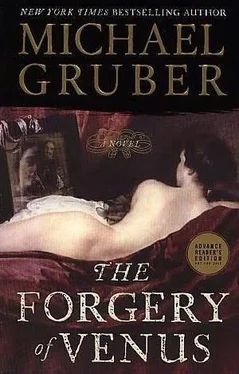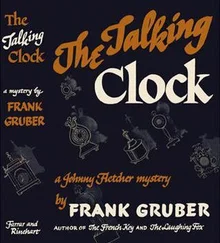I said, “Okay, you got me, tell me more about this palazzo job.”
And he did, and it turned out that the palazzo had been vacant for a while and the roof leaked and the ceiling had essentially collapsed, so it wasn’t a restoration job exactly but more like a reproducing job. Which kind of pissed me off, because it was getting into the forgery zone, but he said, “Not at all, no way, not only do we have a photo of the ceiling, but we even have Tiepolo’s original cartoons for the thing, you’ll be one with the masters, except with electricity.”
“You know this Italian guy personally?” I asked.
“Castelli,” he said, “Giuseppe. He’s big in cement and construction, builds airports, bridges, like that.”
“But do you know him?”
“Not as such. I met him at a dinner Werner Krebs organized in Rome. That name mean anything to you?”
“No. Should it?”
“Probably not. He’s an art dealer. Old masters. Very big in Europe, private sales, multimillion-dollar level.”
“Well, that lets me out of his circle, being a young master myself.”
“Yeah, you could say that. You know, Wilmot, you’re a fucking piece of work. You’re always broke, you do shit magazine work for peanuts, and all the time you’re sitting on a million-dollar talent. Christ, you could be another Hockney.”
“Maybe I don’t want to be another Hockney.”
“Why not, for crying out loud? Look, you want to do representational? You think I can’t sell representational? There are people dying for representational work. They only buy the conceptual and abstract shit because they think they should, because people like me tell them to buy it. But they hate it, if you really want to know the truth; what they’d really like is an old master, or a Matisse, or a Gauguin, something where they don’t have to read the artist’s statement to know what’s going on. I’m talking people who have a million, a million and a half to spend on art. It’s a huge fucking market. Why aren’t you getting rich off it?”
I finished my glass of wine and filled the glass again. “I don’t know,” I said lamely. “Whenever I think about doing another gallery show it makes me sick. I want to get drunk, dope myself into oblivion.”
“You ever think about seeing someone about that little problem?”
“A shrink. Yeah, oh, Doctor, save me, I can’t participate in the corruption of the art market! Vermeer had the same problem, you’ll recall. He did about one painting a year, and when he could bring himself to sell one, sometimes he used to go and try to buy it back. Then his wife would take the painting back to the buyer and beg him for the money again.”
“So he was a nut. So was van Gogh. What does that prove? We’re talking about you, the Luca Giordano of our age.”
“The who?”
“Luca Giordano, the painter, Neapolitan, late seventeenth century. Hey, you’re an art major. You took Italian painting in the seventeenth.”
“I must’ve been out that day. What about him?”
“Fastest brush in the west, and he could imitate any style. They called him the Thunderbolt, or Luca Fá Presto, Luca Go Faster. Interesting guy, a major influence on Tiepolo, as a matter of fact. Never developed a real style of his own, but that didn’t matter, because if you wanted a sort of Rubens, or a sort of Ribera, Luca was the man to see. He once did a Durer that was sold as a genuine Durer, and then he told the guy who bought it that he’d done it.”
“Why would he do that?”
“Because he wasn’t a forger. The client took him to court for fraud, but Luca got off when he showed the judge that he signed the painting with his own name and covered it with a layer of paint, and also that he never personally stated it was a Durer. He left that to the so-called experts. The judge threw the case out of court. After that it was balls to the wall for Luca; he imitated just about every famous artist of his time, and the previous generation too: Veronese, the Caraccis, Rembrandt, Rubens, Tintoretto, Caravaggio-especially Caravaggio. And always with the hidden signature, so he could skate on any forgery charges. When he was court painter to Carlos the Second in Spain, he forged a Bassano from a private collection, a picture he knew that the king wanted, and after it got bought he told the king it was a fake and showed him the hidden signature. The king cracked up, he thought it was terrific and complimented him on his talent. I mean, the guy was a rogue, but a genius with a brush.”
“So are you paying me a compliment with this comparison?” I asked. “Or is it a put-down?”
“I don’t know,” he said slyly. “However you want to take it. Meanwhile, I’m sitting here with a guy who could make literally millions off his talent and he’s pissing it away with hack work, and when he finally does a show, hallelujah, he does it at his ex-wife’s low-end gallery. It offends my professional dignity, is what it is, like if I was a theatrical agent and I went to a coffee shop every day and there was Julia Roberts or Gwyneth Paltrow slinging hash. What is this gorgeous woman doing here, I’d ask myself, and I’d want to do something about it. Not to mention you’re an old pal.”
“How did you know I was having a show at Lotte’s?”
He shrugged. “I have my ways. Very little goes on in the art world in the city that I don’t get to hear about. Anyway, I don’t want to be a bore about it, but if you ever want to get your hands on some serious money…for example, did I tell you my idea about almost-old masters?”
I said he hadn’t and he told me.
“Let’s say you’re a guy who’s clearing, say, ten million a year in, I don’t know, real estate or Wall Street, whatever. There’re fifty thousand guys like that in the city, right? This guy’s got everything, the apartment, the house on the Island, the car, his kids are going to the top schools, he’s got a small collection of important pieces, modern stuff, but appreciating pretty well-”
“Which he bought on your recommendation, of course.”
He laughed. “Of course. We stipulate the guy’s sharp. So what this guy can’t buy yet is major art: Cézanne, van Gogh, Picasso, they’re all out of range, not to mention Rembrandt, Breughel, the old masters. It’s a gap in his self-image. Also, let’s say his wife likes traditional furnishings. He can’t hang a Butzer or a Miyake up there, it’d look like shit. But what if I can sell him a nice little Cézanne fake, a nice almost-Reni madonna, the gilt frame, the little brass light above it. No one but an expert can tell it from the real thing. Obviously, we’re not going to do Girl with the Red Hat or the Mona Lisa, not at all. We’re going to do obscure stuff, small but beautiful. The guests come in and they say, ‘Hey, is that a Cézanne?’ And our guy says, ‘It may be. I picked it up for a song.’”
“These will be signed?”
He wrinkled his face disapprovingly. “Of course not signed! Jesus, that’s all I need! No, it’d be exactly like, you know, fake gems, cubic zirconiums. A woman has a forty-carat ring, she doesn’t wear it to the grocery store or the country club. It’s in a vault and she wears a custom-made fake, which all her friends accept because one, they all do the same thing, and two, because they know she’s got the real jewels. So our guy is demonstrating he’s got taste, and also-and this is the big selling point-maybe he’s got a lot more money than his pals thought, because look what’s on the walls-Cézanne, Corot. What do you think?”
“I think it’s a terrific idea, Mark. It’s pretentious and false, yet at the same time completely legal. I can’t think of another gallery owner who could have come up with it.”
Читать дальше












